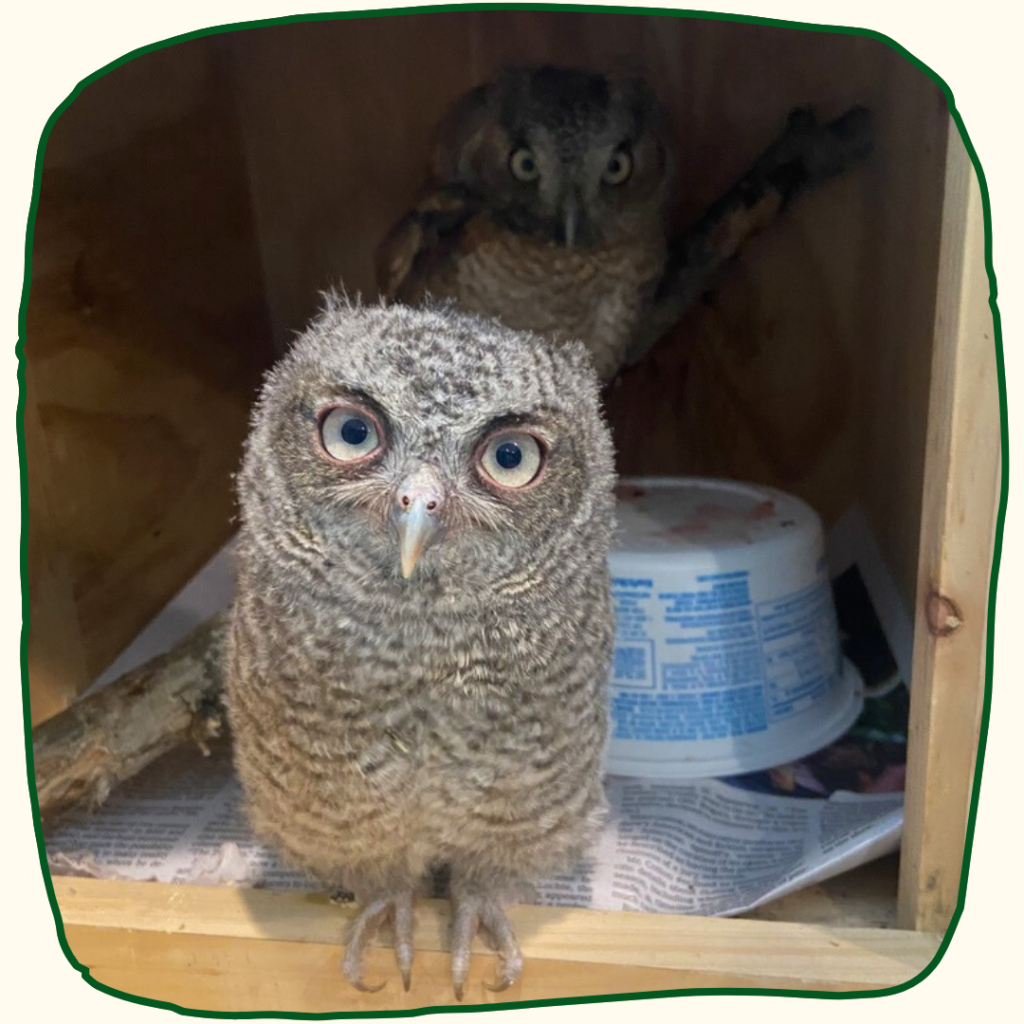May was busy, but we’re screeching in June! This month, we’re highlighting Eastern Screech-Owl patients 24-447, 448, and 504.

Each of these three charmingly scruffy owlets (yes, owlets!) arrived in rehabilitative care as a lone orphan. Our staff assigns patient numbers to new patients chronologically, so you can tell there was a gap between the first two admits and their third “nestmate.” The first two were transferred to us for longterm care from our friends at the Wildlife Center of Virginia. Both of them were found alone on the ground, with no nest nor parents nearby to attempt renesting them. The third owlet came in as a lone orphan just 5 days (but 50+ patients later at RWS!) after we admitted the first two, having been cared for by members of the public illegally for a couple of days before bringing it in to RWS. 😣

We might sound like a broken record, but remember that wildlife rehabilitation is a “don’t try this at home, folks!” kind of job. Raptors, also called birds of prey, are extremely sensitive as youngsters. Improper human handling can lead to them becoming irreversibly habituated to humans. This is sometimes called “imprinting” and renders a raptor non-releasable for the duration of its life. 😞 (That’s why education ambassador Rosie lives at RWS!) If you think the ugly-cute baby raptor you’ve found needs help, please call us or your nearest permitted rehabber first. We’re often able to help callers successfully re-nest fallen owlets. Happy reunions between parents and babies are always pure magic!
We take extreme precaution when working with young birds of prey to prevent imprinting. This includes absolute silence in the room with them, save for a noise machine to help drown out facility noises from other rooms. It also involves some very fashionable headgear to cover our faces and eyes when feeding these owlets, as seasonal rehab staffer Jillian and rehabilitation program manager Elka are modeling below! 💅

The three Eastern Screech-Owls have a customized rehabilitation plan and are currently doing well at the Sanctuary thanks to some committed meal prep by our team. Adult owls are able to swallow prey whole, regurgitating the indigestible feathers, fur, and bones from their prey later on in a pellet form. (Remember dissecting owl pellets in grade school?) However, young owls are not able to pellet until they’re capable of eating whole prey, so our staff must prepare their meals the same way their wild mom and dad would: no fur, no bones. We’ll spare you the gory details, but let’s just say our rehab staffers have strong stomachs when we have baby raptors in care! We then tong-feed them, with our faces covered, teasing their beaks like their parents would to get them to eat. Luckily, the owlets are progressing through developmental stages appropriately and have begun to self-feed more successfully. 💪

Once the owlets are reliably self-feeding, they’ll graduate to one of our raptor flight enclosures outdoors. There, they’ll acclimate to natural weather patterns, practice flying, get daily enrichment to encourage their sensory development, and take the final test: Mouse School. The only time we use live prey at RWS is when we’re evaluating our obligate predators, like red foxes and birds of prey, for release. We maintain our own small mouse colony at the Sanctuary, ensuring that they receive a happy, healthy, and humane life before they are involved in Mouse School. In fact, one of our summer interns’ favorite tasks is to care for the mouse colony each day! 🐭
To set up Mouse School, we build a lush mouse habitat inside the owls’ flight enclosure. We fill it with lots of leaf litter, hidey holes, shelters, and food and water. We assess each owl individually by containing its nestmates in a different enclosure overnight. Then, the owl is left alone with the mouse habitat. We count how many mice (if any at all) they are able to successfully hunt overnight. If they succeed, they are ready for release! 🎉

Now, you’re probably wondering about the subject line of this email. “Weeeeekrkrkrkrkr” is our best attempt at writing the sound Eastern Screech-owls make! (Our best attempt does not mean it’s a good one. 🤣) Their songs sound like a high-pitched whinny followed by a series of trills, though there is a wide variation. We encourage you to explore the interesting but somewhat haunting calls collected by the Cornell Lab of Ornithology. Is it spooky season yet?! 👻
We hope these owlets put a smile on your face today, like they do for us – except you can’t see ours under those oh-so-chic full coverage owl-feeding hats! 🧢
June 19, 2024
Published:
Be the first to comment!